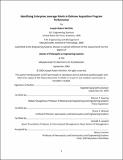Identifying enterprise leverage points in Defense Acquisition Program performance
Author(s)
Wirthlin, Joseph Robert, 1970-
DownloadFull printable version (14.94Mb)
Other Contributors
Massachusetts Institute of Technology. Engineering Systems Division.
Advisor
Warren P. Seering.
Terms of use
Metadata
Show full item recordAbstract
Large, complex systems development programs in the Department of Defense are finding it more difficult to deliver desired capabilities to the end user on time and on budget than ever before. Evidence exists that almost all developmental programs on record are over cost and schedule, costing the Department and ultimately the U.S. taxpayer billions of dollars more than anticipated. Numerous studies over many decades have addressed various aspects of the problems plaguing these efforts with many recommendations. Unfortunately, most of these recommendations have been ignored or poorly implemented with limited success. This work embodies an exploratory systems approach to characterize the system of acquiring large, complex, socio-technological systems for the Department of Defense. Through a series of qualitative studies and in-depth interviews with individuals working in the Joint Capabilities Integration Development System (JCIDS), the Planning, Programming, Budgeting, and Execution (PPBE) process, and the Acquisition system, a model of the larger "enterprise of acquisition" or Acquisition System was developed. The model has a scope ranging from the very early beginnings of any program through the conclusion of developmental activities. The methodology used consisted of stringing together the individual pieces of the system defined by probabilistic distributions of time and corresponding probabilistic decision points into a model ideal for discrete-event simulation. An extensive program of verification and validation of the model was carried out to increase confidence in the model and its simulation outcomes. (cont.) Experimental system interventions, designed to mimic potential policy interventions and/or system changes, were introduced into the model and the corresponding outcomes analyzed. Results show several interventions have varying degrees of influence and suggest no single antidote exists for solving the problems related to Acquisition. Furthermore, many of the outcomes of the system can be described as emergent behaviors versus problems stemming from poor program management, program risk management, or requirements management.
Description
Thesis (Ph. D.)--Massachusetts Institute of Technology, Engineering Systems Division, 2009. This electronic version was submitted by the student author. The certified thesis is available in the Institute Archives and Special Collections. Cataloged from student submitted PDF version of thesis. Includes bibliographical references (p. 218-223).
Date issued
2009Department
Massachusetts Institute of Technology. Engineering Systems DivisionPublisher
Massachusetts Institute of Technology
Keywords
Engineering Systems Division.